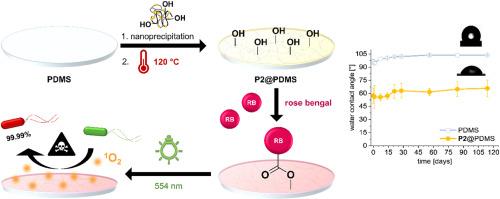稳定的,生物活性的水凝胶涂层在有机硅表面的非侵入性净化通过光化学处理
IF 18
1区 医学
Q1 ENGINEERING, BIOMEDICAL
引用次数: 0
摘要
聚二甲基硅氧烷(PDMS)因其生物相容性、化学稳定性、柔韧性和在生理环境中的抗降解性而广泛应用于生物医学领域。然而,其固有的惰性限制了进一步的(生物)功能化,其疏水性恢复损害了传统表面修饰的寿命。为了解决这些挑战,我们开发了一种纳米沉淀法,用于直接胶体沉积、共价热交联和具有活性羟基的化学可调、生物相容性聚丙烯酰胺的表面锚定,从而实现进一步的表面修饰。该聚合物包含约6%的生物激发儿茶酚单元,通过优雅的单锅卡巴尼克场反应引入,以促进热诱导网络的形成,并增强与等离子体激活的PDMS的粘附性。所得到的均匀涂层具有可调的干层厚度达44±7 nm,并且即使在蒸汽高压灭菌后也能有效抑制PDMS链重排,确保在水环境和环境中至少90天的长期稳定性。通过在表面浓度为20或40 μg cm−2的情况下固定光敏剂rose bengal,在概念验证研究中证明了生物活性修饰后的潜力。该涂层显示出对金黄色葡萄球菌的抗菌活性,即使细菌悬浮在液体中,没有直接表面接触,在554nm (342jcm−2)照射30分钟后,菌落形成单位减少了4对数(99.99%)。相比之下,对大肠杆菌的抗菌活性仅在最小的液体体积下观察到,使活动细菌与表面密切接触。这项工作为PDMS表面的稳定和生物活性功能化建立了一个简单而通用的策略,用于非侵入性表面净化。本文章由计算机程序翻译,如有差异,请以英文原文为准。

Stable, bioactive hydrogel coating on silicone surfaces for non-invasive decontamination via photochemical treatment
Polydimethylsiloxane (PDMS) is widely used in biomedical applications due to its biocompatibility, chemical stability, flexibility, and resistance to degradation in physiological environments. However, its intrinsic inertness limits further (bio)functionalization, and its hydrophobic recovery compromises the longevity of conventional surface modifications. To address these challenges, we developed a nanoprecipitation method for the straightforward colloidal deposition, covalent thermal crosslinking, and surface anchoring of a chemically tunable, biocompatible polyacrylamide with reactive hydroxyl groups, enabling further surface modifications. This polymer incorporates ∼6 % bioinspired catechol units, introduced via an elegant one-pot Kabachnik-Fields reaction, to facilitate thermally induced network formation and enhance adhesion to plasma-activated PDMS. The resulting uniform coatings exhibited tunable dry layer thicknesses up to 44 ± 7 nm and effectively suppressed PDMS chain rearrangement even after steam autoclaving, ensuring long-term stability in aqueous and ambient environments for at least 90 days.
The bioactive post-modification potential was demonstrated in a proof-of-concept study by immobilizing the photosensitizer rose bengal at surface concentrations of 20 or 40 μg cm−2. The coating exhibited antimicrobial activity against S. aureus, achieving a 4-log reduction (99.99 %) in colony-forming units after 30 min of irradiation at 554 nm (342 J cm−2), even when bacteria were suspended in liquid, without direct surface contact. In contrast, antimicrobial activity against E. coli was only observed with minimized liquid volume, bringing the motile bacteria into close contact with the surface.
This work established a straightforward and versatile strategy for the stable and bioactive functionalization of PDMS surfaces for application in non-invasive surface decontamination.
求助全文
通过发布文献求助,成功后即可免费获取论文全文。
去求助
来源期刊

Bioactive Materials
Biochemistry, Genetics and Molecular Biology-Biotechnology
CiteScore
28.00
自引率
6.30%
发文量
436
审稿时长
20 days
期刊介绍:
Bioactive Materials is a peer-reviewed research publication that focuses on advancements in bioactive materials. The journal accepts research papers, reviews, and rapid communications in the field of next-generation biomaterials that interact with cells, tissues, and organs in various living organisms.
The primary goal of Bioactive Materials is to promote the science and engineering of biomaterials that exhibit adaptiveness to the biological environment. These materials are specifically designed to stimulate or direct appropriate cell and tissue responses or regulate interactions with microorganisms.
The journal covers a wide range of bioactive materials, including those that are engineered or designed in terms of their physical form (e.g. particulate, fiber), topology (e.g. porosity, surface roughness), or dimensions (ranging from macro to nano-scales). Contributions are sought from the following categories of bioactive materials:
Bioactive metals and alloys
Bioactive inorganics: ceramics, glasses, and carbon-based materials
Bioactive polymers and gels
Bioactive materials derived from natural sources
Bioactive composites
These materials find applications in human and veterinary medicine, such as implants, tissue engineering scaffolds, cell/drug/gene carriers, as well as imaging and sensing devices.
 求助内容:
求助内容: 应助结果提醒方式:
应助结果提醒方式:


